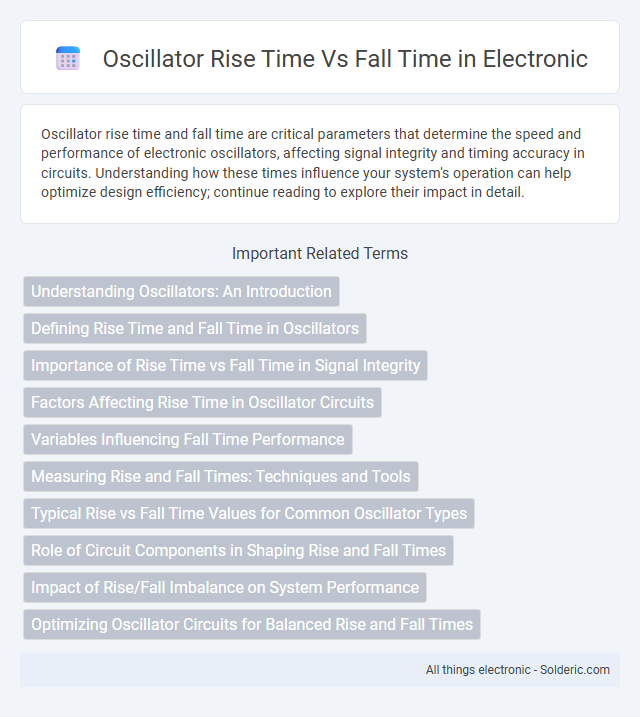Oscillator rise time and fall time are critical parameters that determine the speed and performance of electronic oscillators, affecting signal integrity and timing accuracy in circuits. Understanding how these times influence your system's operation can help optimize design efficiency; continue reading to explore their impact in detail.
Comparison Table
| Parameter | Rise Time (Tr) | Fall Time (Tf) |
|---|---|---|
| Definition | Time for signal to transition from 10% to 90% of peak amplitude | Time for signal to transition from 90% to 10% of peak amplitude |
| Measurement Range | Ascending edge of waveform | Descending edge of waveform |
| Impact on Signal Quality | Affects timing precision and high-frequency response | Influences signal distortion and switching speed |
| Typical Duration | Usually in nanoseconds to microseconds depending on oscillator type | Often similar or slightly different than rise time; depends on design |
| Optimization Focus | Minimized for faster response in high-speed applications | Reduced to limit power dissipation and ringing |
Understanding Oscillators: An Introduction
Oscillator rise time and fall time refer to the durations it takes for an oscillator signal to transition from a low to high state and from a high to low state, respectively. These parameters are crucial in determining signal integrity and frequency stability in electronic circuits, with faster rise and fall times indicating sharper transitions and higher performance. Understanding these timing characteristics helps engineers optimize oscillator design for applications requiring precise timing and minimal signal distortion.
Defining Rise Time and Fall Time in Oscillators
Rise time in oscillators refers to the duration it takes for the output signal to transition from a low voltage level (typically 10%) to a high voltage level (typically 90%). Fall time is the opposite, measuring the time for the signal to drop from the high voltage level back down to the low voltage level. Understanding your oscillator's rise and fall times is crucial for optimizing signal integrity and ensuring accurate timing in high-speed electronic circuits.
Importance of Rise Time vs Fall Time in Signal Integrity
Rise time and fall time are critical parameters in oscillators that directly impact signal integrity by determining the sharpness of signal transitions. Faster rise times enable more accurate timing and reduced jitter, while slower fall times can cause signal distortion and increased electromagnetic interference (EMI). Optimizing your oscillator's rise and fall times ensures cleaner signal edges, minimizing data errors and improving overall circuit performance.
Factors Affecting Rise Time in Oscillator Circuits
Rise time in oscillator circuits is influenced by factors such as the intrinsic capacitance and inductance of circuit components, the driving current strength, and the oscillator's load conditions. Device parasitics and material properties can also impact the speed at which the signal transitions from low to high voltage levels. Understanding these factors helps optimize your oscillator's rise time for improved signal integrity and performance.
Variables Influencing Fall Time Performance
Fall time performance in oscillators is influenced by several key variables, including the transistor switching speed, load capacitance, and circuit layout parasitics. Higher load capacitance increases the discharge path duration, slowing down the fall time, while faster transistor transition times improve overall fall time speed. Your oscillator's fall time can be optimized by minimizing parasitic capacitance and resistance in the output stage to achieve sharper signal transitions.
Measuring Rise and Fall Times: Techniques and Tools
Measuring rise and fall times accurately involves using high-speed oscilloscopes equipped with appropriate probes, such as active or differential probes, to capture transient signals without distortion. Techniques include triggering on specific voltage thresholds or time intervals and employing signal averaging to reduce noise and improve measurement precision. Your choice of measurement tools and methods directly impacts the reliability of rise time and fall time data in oscillator performance analysis.
Typical Rise vs Fall Time Values for Common Oscillator Types
Typical rise times for crystal oscillators range from 5 to 20 nanoseconds, while fall times are often slightly faster, between 3 to 15 nanoseconds, due to the inherent properties of the quartz crystal and its drive circuitry. CMOS oscillators typically exhibit symmetrical rise and fall times, generally around 1 to 3 nanoseconds, supporting fast switching speeds ideal for digital applications. Understanding these timing characteristics helps you select the right oscillator type to optimize signal integrity and overall system performance.
Role of Circuit Components in Shaping Rise and Fall Times
Resistors, capacitors, and transistors play critical roles in determining oscillator rise and fall times by affecting charge and discharge rates within the circuit. RC time constants set the tempo for voltage transitions, where larger capacitance or resistance values typically increase rise and fall durations. Your choice of semiconductor devices influences switching speed, directly impacting the oscillator's ability to achieve fast and consistent signal edges.
Impact of Rise/Fall Imbalance on System Performance
Rise time and fall time imbalances in oscillators can cause skew and timing jitter, degrading signal integrity and synchronization in high-speed digital systems. Unequal transition durations increase electromagnetic interference (EMI) and power dissipation, impacting the overall efficiency and reliability of communication interfaces. Precise control of rise/fall symmetry is essential for minimizing timing errors and optimizing the performance of clock distribution networks and RF circuits.
Optimizing Oscillator Circuits for Balanced Rise and Fall Times
Optimizing oscillator circuits for balanced rise and fall times enhances signal integrity and reduces timing errors in high-speed applications. Achieving symmetry involves careful selection of transistor sizes, load capacitances, and bias currents to ensure uniform switching characteristics. By fine-tuning these parameters, your oscillator can deliver stable frequency performance with minimized jitter and distortion.
Oscillator rise time vs Fall time Infographic

 solderic.com
solderic.com